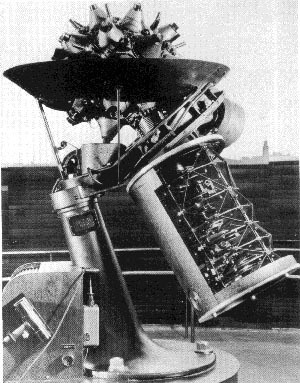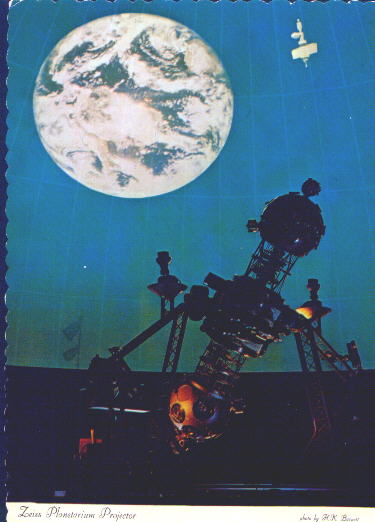
The world's first projection planetarium, the
Zeiss Mark I in the Deutsches Museum in
Munich in the Autumn of 1923. The concept for
a projection planetarium was devised almost a
decade earlier.
(Image Source: Wikipedia.org )
By Glenn A. Walsh
Reporting for SpaceWatchtower
100 years ago today, on 1914 February
24, the concept of the projection planetarium was born, at a meeting
of staff scientists of the Carl Zeiss Company in Jena, Germany. Due to
delays caused by the First World War, the first actual planetarium
projector would not be produced until nearly a decade later.
The idea came as a solution to a
problem brought on by a request from a client, Oskar von Miller. Mr.
von Miller, a well-known German engineer, had spearheaded the
establishment of the first modern-type science and technology museum,
the Deutsches Museum in Munich, Germany, which opened to the public
on 1906 November 12. In 1913, German Astronomer Max Wolf, former Director of the Baden Observatory in Heidelberg, urged Mr.
von Miller to include, in the Deutsches Museum, a way to
realistically reproduce the night sky, in detail, including the
motions of the planets.
In 1913 (before Chicago's Adler
Planetarium opened in 1930), a large-scale, mechanical celestial
sphere, called the Atwood Sphere, opened to the public in the Museum
of the Chicago Academy of Sciences (today, it is displayed in the
Adler Planetarium and Astronomy Museum). In a mechanical celestial
sphere, a small number of people would enter an enclosure where light
from outside the enclosure would twinkle through small holes in the
sphere, as a display of stars that could be seen outdoors;
additionally, the sphere would spin around the viewers demonstrating
star movement. The concept of a mechanical celestial sphere, large
enough to accommodate at least ten people, dates back to 1664 when
the Globe of Gottorf was installed in the Kunstkammer Museum in Saint
Petersburg, Russia.
Mr. von Miller wanted a mechanical
celestial sphere for the Deutsches Museum. However, he asked that the
Carl Zeiss scientists find a way to also display the movements of the
Sun, Moon, and planets in the celestial sphere, something that was
not included in previous spheres.
Two Carl Zeiss scientists, Walther
Bauersfeld and Rudolf Straubel, offered an
alternative a century ago, today: replace the small celestial sphere
with a giant hemispheric dome, and use a bright central lamp to
project the planets and stars onto the dome-sky.
This was the first concept for a
projection planetarium. Actually, it was also the first concept of a
true, large-scale planetarium,
as, except for a small-scale orrery, the previous celestial spheres
had no way to demonstrate the motions of the planets.
A very
primitive projection planetarium had been invented in 1912 by
Professor E. Hindermann in Basel, Switzerland. Called an Orbitoscope,
this spring-driven instrument included only two planets orbiting a
Sun. A small light bulb on one planet projected shadows on the other
two objects, accurately displaying retrograde loops and speed
changes, but not much else.
Well
after the end of World War I, the Carl Zeiss Company first
demonstrated a large-scale projection planetarium in August of 1923,
in a 16-meter dome set-up on the company's factory roof in Jena. The
Zeiss Model I, known as the “Wonder of Jena,” was then dismantled
and shipped to the Deutsches Museum.
On
1923 October 21, Mr. Bauersfeld, the Carl Zeiss Company Chief Design Engineer, demonstrated the Zeiss I in a program for invited guests
at the Deutsches Museum. As the first public planetarium show, the
professional and public reaction was enthusiastic. The planetarium
projector was then returned to the Jena factory for finishing
touches, and then permanently installed in the Munich museum in May
of 1925.
This
new educational tool greatly impressed scientists and civic leaders
in Germany, resulting in six other German cities receiving Zeiss
planetarium projectors by the end of 1926. By 1930, five more German
cities had projectors. A much improved Zeiss Model II soon superceded the Zeiss I.
In
1927, the first Zeiss projector outside of Germany was installed in
Vienna, and then a projector was installed in Rome in 1928 and one
in Moscow in 1929. Other European cities to receive planetarium projectors from the Carl Zeiss Company, prior to World War II,
included Stockholm (1930), Milan (1930), and Paris (1937). The first
Asian planetarium projectors appeared in Osaka in 1937 and Tokyo in
1938.
Five
Zeiss planetarium projectors were installed in America prior to World
War II. The first came to the new Adler Planetarium and Astronomy
Museum in Chicago in 1930. Founded by Chicago business leader Max
Adler, the institution is now part of Chicago's Museum Campus, which
includes the Field Natural History Museum and the Shedd Aquarium. A
visit in 1930 by Amateur Astronomers Association of Pittsburgh
co-founder Leo Scanlon, and other members of the club, inspired the
club to lobby for a planetarium to be built in Pittsburgh.
The
second, the Fels Planetarium, was installed as part of Philadelphia's
Franklin Institute in 1933; the planetarium opened two months before
the Franklin Institute Science Museum was completed in 1934. It is said that
Samuel S. Fels, the soap company president and philanthropist who
funded the planetarium, missed the debut performance in Fels
Planetarium. He was late and refused to be seated late, as he felt
nothing should interrupt a planetarium show once it is begun!
Two
American planetaria opened in 1935. On May 14, Griffith Observatory
and Planetarium opened in Griffith Park in Los Angeles. While the
large planetarium dome is in the center of the facility, two smaller
observatory domes are on the east and west sides of the building. The
east dome houses a 12-inch Zeiss refractor telescope, one of the
earliest public observatories; solar telescopes are housed in the
west dome, with a coelostat which sends the images to the public
exhibit gallery. Located on a high hill just above Hollywood,
Griffith has been included in numerous motion pictures and television
programs.
Hayden
Planetarium opened in New York City's long-established American
Museum of Natural History on 1935 October 3. After a very
controversial renovation, which included the demolition of the
original Hayden Planetarium building, the new Hayden Planetarium
opened as part of the much larger and more impressive Rose Center for
Earth and Space in 2000. Astrophysicist Neil deGrasse Tyson,
nationally known as a host of PBS science programs, is the long-time
Director of the Hayden Planetarium.
Also
in 1935, the Buhl Foundation committed to building a planetarium in
Pittsburgh, in memory of department store co-founder Henry Buhl, Jr.
Opened in 1939, Pittsburgh's original Buhl Planetarium and Institute
of Popular Science included five public galleries of
exhibits of the physical sciences, and even one life science presentation. A public observatory, with a rather unique 10-inch Siderostat-type refractor telescope, was added in 1941.
Buhl
Planetarium's Zeiss II Planetarium Projector was the first such
projector to be placed on an elevator, and the Theater of the Stars
was the first planetarium theater to include a permanent theatrical
stage and a special sound system for the hearing-impaired. Buhl used
their Zeiss II, with no major modifications, until the building
closed as a public museum in 1991. The Zeiss II is now on public
exhibit, but not in use, in Pittsburgh's Carnegie Science Center,
where the Henry Buhl, Jr. Planetarium and Observatory now utilizes a
full-dome, digital projection system. 2014 is the 75th
year of Pittsburgh's Buhl Planetarium.
Two
American-built star projectors are of special note. In 1937, the
Korkosz brothers installed a projector, which projects 9,500 stars but
no planets, in the Springfield Museum of Science in Springfield,
Massachusetts. Including a major restoration in 1996, the staff of
the Springfield Museum of Science have lovingly maintained this
historic projector, which continues providing astronomy education to young and old alike, to
this day!
After
World War II, neither Zeiss factory in war-torn Germany was capable
of producing planetarium projectors for several years. Thus, the
California Academy of Sciences decided to build a one-of-a-kind
planetarium projector for the Morrison Planetarium in San Francisco,
which opened in 1952. Today, Morrison Planetarium claims to have the
world's largest all-digital planetarium.
With
the post-war boom in America, many new educational facilities were
constructed in the second half of the twentieth century, including
new planetaria, science museums, and public libraries. New technology
has changed the planetarium experience and increased the educational
capabilities of planetaria. Likewise, planetarium-type computer
programs have brought the planetarium experience to school and home
computers, and even to hand-held smart telephones.
"Who Made That Planetarium?
The New York Times On-Line 2014 Feb. 7.
Link >>> http://www.nytimes.com/2014/02/09/magazine/who-made-that-planetarium.html?src=recg&_r=0
More on the Historic Atwood Sphere:
Link >>> http://dees2.blogspot.com/2007/06/finally-atwood-sphere.html
History of the Adler Planetarium and Astronomy Museum: Link >>> http://adlerplanetarium.tripod.com/
History of The Buhl Planetarium and Institute of Popular Science:
Link >>> http://buhlplanetarium.tripod.com/75years/quickhistory.html
History of the Korkosz Projector, Springfield Museum of Science:
Link >>> http://www.pielock.com/kork.htm
More Links to History of the Planetarium:
Link >>> http://buhlplanetarium.tripod.com/Buhlbriefhistory.html#links
Special Thanks: Eric G. Canali, former Floor Manager, Pittsburgh's original Buhl Planetarium and Institute of Popular Science and Founder, South Hills Backyard Astronomers amateur astronomy club.
Special Thanks: Peter Volz, for the correction of the given name of one of the two Carl Zeiss scientists (Rudolf Straubel, not Werner Straubel) who "offered an alternative a century ago, today: replace the small celestial sphere with a giant hemispheric dome, and use a bright central lamp to project the planets and stars onto the dome-sky." The correction has now been made in the text.
Source: Glenn A. Walsh Reporting for SpaceWatchtower, a project of Friends of the Zeiss.
2014: 75th Year of Pittsburgh's Buhl Planetarium

Want to receive SpaceWatchtower blog posts in your inbox ?
Send request to < spacewatchtower@planetarium.cc >..
gaw
Glenn A. Walsh, Project Director,
Friends of the Zeiss < http://buhlplanetarium.tripod.com/fotz/ >
Electronic Mail - < gawalsh@planetarium.cc >
About the SpaceWatchtower Editor / Author: < http://buhlplanetarium2.tripod.com/weblog/spacewatchtower/gaw/ >
SpaceWatchtower Blog: < http://spacewatchtower.blogspot.com/ >
Also see: South Hills Backyard Astronomers Blog: < http://shbastronomers.blogspot.com/ >
Barnestormin: Writing, Essays, Pgh. News, & More: < http://www.barnestormin.blogspot.com/ >
SPACE & SCIENCE NEWS, ASTRONOMICAL CALENDAR:
< http://buhlplanetarium.tripod.
Twitter: < https://twitter.com/spacewatchtower >
Facebook: < http://www.facebook.com/pages/
Author of History Web Sites on the Internet --
* Buhl Planetarium, Pittsburgh:
< http://www.planetarium.
* Adler Planetarium, Chicago:
< http://adlerplanetarium.
* Astronomer, Educator, Optician John A. Brashear:
< http://johnbrashear.tripod.com >
* Andrew Carnegie & Carnegie Libraries:
< http://www.andrewcarnegie.
* Civil War Museum of Andrew Carnegie Free Library:
< http://garespypost.tripod.com >
* Duquesne Incline cable-car railway, Pittsburgh:
< http://inclinedplane.tripod.
* Public Transit:
< http://andrewcarnegie2.tripod.
I think you provide best thin client software services.Thanks for sharing this informative blog.
ReplyDeleteThin Clients & Zero Client
dewacintaqq
ReplyDeletedewacintaqq.com
dewa cintaqq
daftar dewacintaqq
link alternatif dewacintaqq
dewacintaqq
dewacintaqq.com
dewa cintaqq
daftar dewacintaqq
link alternatif dewacintaqq
dewacintaqq
dewacintaqq.com
dewa cintaqq
daftar dewacintaqq
link alternatif dewacintaqq
dewacintaqq
dewacintaqq.com
dewa cintaqq
daftar dewacintaqq
link alternatif dewacintaqq
DewacintaQQ
link alternatif Dewacintaqq
Deposit
Deposit dewacintaqq
Poker Indonesia
Poker Online Indonesia
Bandar QQ
Agen Ceme Online
Daftar Situs Poker
Poker Online Terpercaya
Judi Poker
Poker Online Uang Asli
Poker Uang Asli
Situs Poker Online
Agen Poker
Poker88
Capsa Susun Online
daftar idn poker
idnpoker
bigceme
ceme
ceme online
bandar ceme
idn poker
Idnplay
idn play
poker
poker idn
agen poker online
poker online
situs poker online
judi online
situs judi online
Bandar poker terpercaya
situs judi online
situs poker online
-----------------------------------------------------------------------------
Bandarq online terpercaya
Delimapoker situs resmi daftar judi online
aduq uang asli qq online domino QQ
bandarq,judi online
---------------------------------------------------------------------------------
Bandar poker terpercaya
situs judi online
bandar poker
capsa susun
------------------------------------------------------------------------------------
Bandar poker terpercaya
judi poker online
bandar poker online
situs judi online
situs poker online
------------------------------------------------------------------------------------
Bandar poker terpercaya
Poker Indonesia
Poker Online Indonesia
Agen Ceme Online
Daftar Situs Poker
Poker Online Terpercaya
Poker Online Uang Asli
Poker Uang Asli
Situs Poker Online